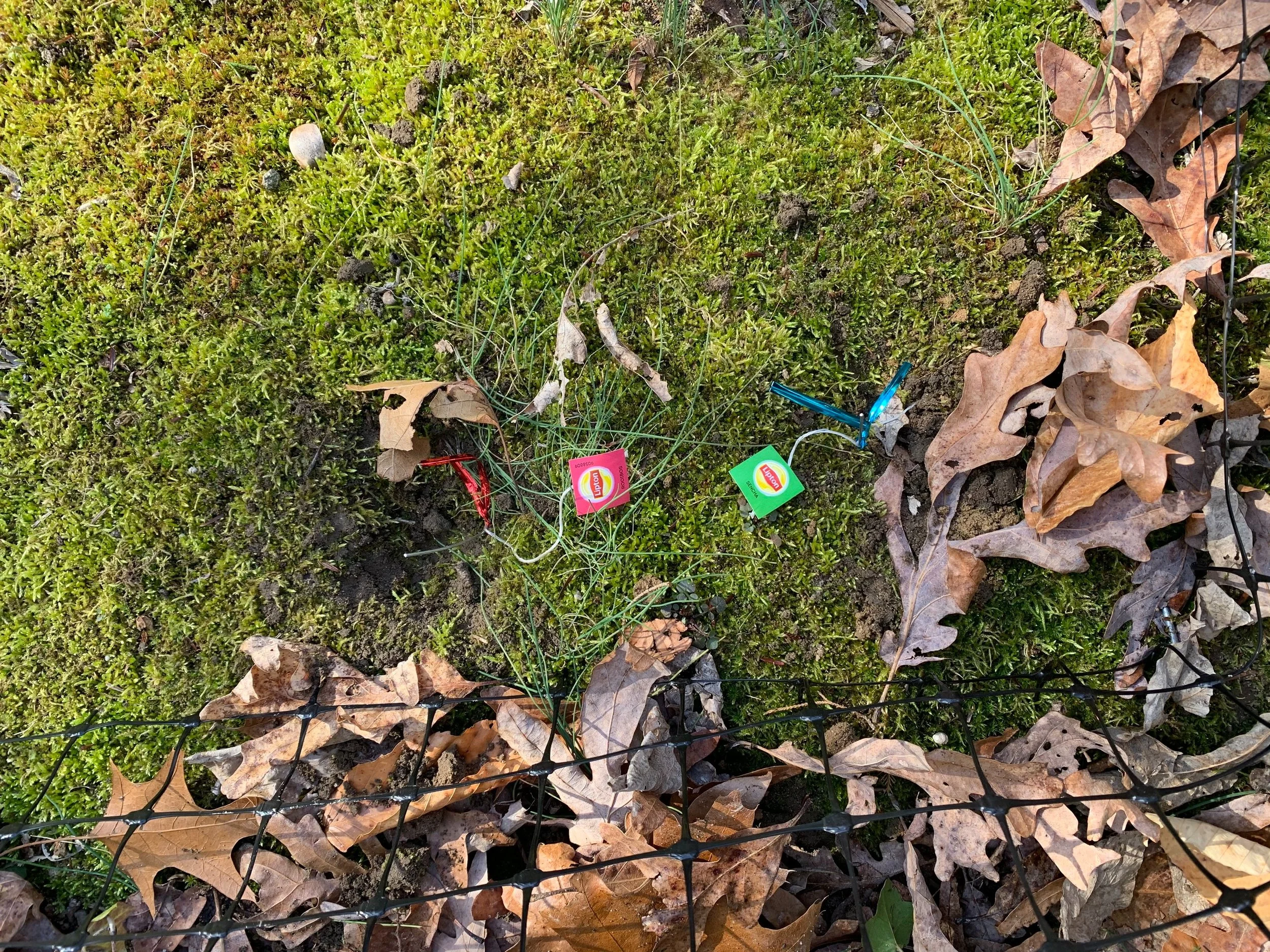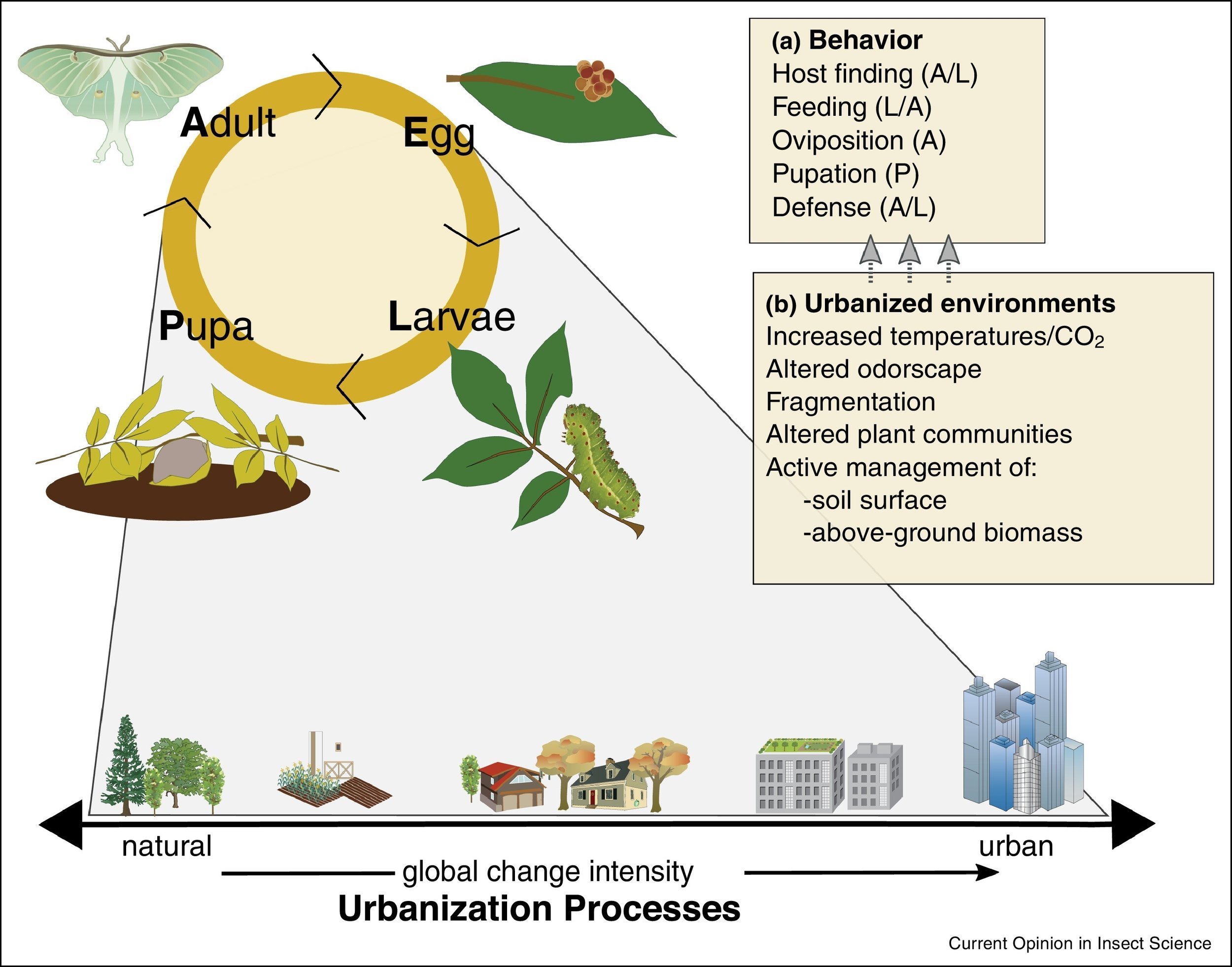Suburban ecosystem studies
Impacts of Leaf Litter Management On Insect Communities
Funding: NSF GRFP
People: Max Ferlauto
Autumn leaf litter management in suburbia is an understudied disturbance to overwintering insects. Litter removal may harm insect communities by directly removing organisms such as moths that overwinter in leaves or by stressing belowground communities by reducing the capacity of the soil to buffer temperatures. To test this, we removed or retained leaf litter from quadrats in twenty suburban properties in Maryland in December. We collected from emergence traps placed on these treatments every 10 days from March to July. Preliminary results show that removing leaf litter reduces moth emergence by up to 67 percent.
We are also using a large-scale tree biodiversity experiment (BiodiversiTREE) to assess if canopy diversity mitigates the effect of litter manipulation on overwintering insects. Here, we used two additional treatments (leaf shredding and leaf piles) to test the effects of common management techniques. Preliminary results show that litter removal and mulching cuts the number of emerging moths almost in half. We did not find an effect of tree diversity, but we are still processing data.
Impacts of Leaf Litter Management and tree diversity on nutrient cycling and decomposition
People: Max Ferlauto and Lauren Schmitt
Seasonal senesced leaf litter removal eliminates considerable organic material from suburban soils annually. We test if this disturbance alters decomposition and carbon cycles and depletes soils of organic matter over time, creating persistent legacy effects.
We used a factorial experimental design to implement 1–2 years of current leaf litter manipulations (remove or retain fallen leaves) within historically raked and unraked areas in suburban Maryland yards. We then compared total organic soil carbon and decomposition using a standardized substrate decomposition methodology (Tea Bag Index) across treatment plots.
Long-term litter removal in suburban yards reduced decomposition rates by 17% and total soil organic carbon concentration by up to 24% compared to areas where leaf litter was retained in situ. In contrast, short-term management changes (1–2 years) did not significantly impact decomposition rates or total organic soil carbon concentrations.
Our findings suggest that long-term suburban litter raking creates legacy effects that alter decomposition and carbon storage process trajectories that are not easily reversed. This is important in understanding urban ecosystem function and sustainable management. Read the full publication in Plants, People, Planet!
At BiodiversiTREE, we manipulated leaf litter in treatments of “retain,” “remove,” “shred,” or “pile” for three years. Because these treatments were nested within the design of the long-term experiment, we can ask questions about how canopy tree diversity interacts with litter management. Preliminary results indicate that diverse mixtures of tree species have increased soil moisture and less soil temperature variation, which can benefit decomposition rates.
Insect Behaviors and life cycles in urban areas
People: Lauren Schmitt
There are many ways in which urban environments might alter insect behavior, but there is very little research exploring how this is or isn’t actually happening. We highlighted existing research and the key research gaps in a review published in Current Opinions in Insect Science. One figure from the paper is included here and described below:
Insect herbivore behaviors (a) are key to the successful completion of insect life cycles within both natural and urbanized habitats. Urbanized environmental conditions (b) likely alter many aspects of these habitats. Herbivore-specific attributes of life cycles include (1) the length of time spent in each life stage (2) the location in the urban environment where that life stage is spent (e.g. leaf, bark, soil surface), and (3) the seasonal timing of each stage. The latter is crucial for determining which stages are spent either overwintering or in aestivation. The life-cycle structure of a species determines which urbanized conditions the species is most likely to come in contact with. For example, species that overwinter in a rolled up leaf on the soil surface (such as the luna moth, Actias luna [Linneaus 1758], illustrated here) are more likely to be negatively affected by fall leaf removal or shredding in urbanized areas. Therefore, conspecifics living in different environments along a gradient of urbanization may experience different selective pressures on the same basic life cycle structure and behaviors. While global change intensity will generally increase along this gradient, management occurs in different forms in the vast majority, if not all, environments. Important insect herbivore behaviors (a) include: host-finding, feeding, oviposition/egg placement, pupation, and anti-predator defense. The primary life stages associated with each behavior are noted in parentheses (A = adult, L = larva, P = pupa).
We also organized a symposium at the 2022 Eastern Branch Entomological Meeting to synthesize research being done on insect conservation in urban areas and highlight non-pest, non-pollinator urban insect ecology.
Image credits: Created by L. Schmitt and K. Burghardt with some individual vector elements from: Tracey Saxby, Jane Hawkey, Jane Thomas, Brianne Walsh, Integration and Application Network, University of Maryland Center for Environmental Science (ian.umces.edu/imagelibrary/).
the role of native plants in supporting biodiversity
People: Karin Burghardt
My undergraduate thesis work investigated the influence of suburban landscaping plants (conventional vs. native) on butterfly and bird abundance and biodiversity. We found that yards landscaped with native plants supported a greater diversity and abundance of birds and Lepidoptera larvae than did conventionally landscaped yards. This effect was driven by differences in insectivorous bird species and included a number of bird species of conservation concern. This research was reported in Conservation Biology.
Native vs. non-native plants -- an insect's perspective
Purple crested slug caterpillar which fed on many native plants in the August sampling of this experiment. Beautiful but they sting!
We studied the abundance and diversity of insect species supported by 56 native and non-native tree species in four large scale common gardens designed to simulate a suburban yard. While non-native plants consistently supported fewer and less diverse insect communities, the effect is most pronounced for non-native plants without a local native congener (eg. a relative in the same genus).
Read more in our publications in Ecology Letters (beta diversity), Diversity and Distributions (diversity and abundance of all herbivorous insect species) and Ecosphere (caterpillars- with a focus on specialists vs. generalists), or check out my collaborator Doug Tallamy's book.
Locations of common gardens across Northern DE and Southern PA.
Aerial shot of the common garden planted at the University of Delaware.
Chris Phillips and Doug Tallamy vacuum-sampling insects from trees within this experiment
Species accumulation curves for each treatment across common gardens standardized by leaf gram vacuum sampled. The largest reduction in herbivore richness on non-native plants was found in immature insects (e.g. caterpillars, leafhopper nymphs) on non-native plants that do not have a close native relative in the study area.










